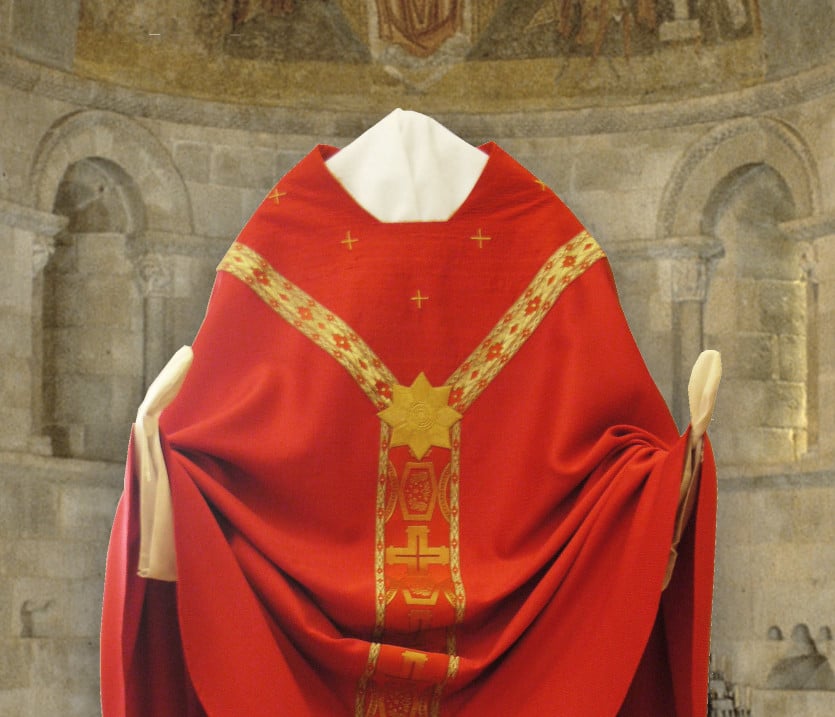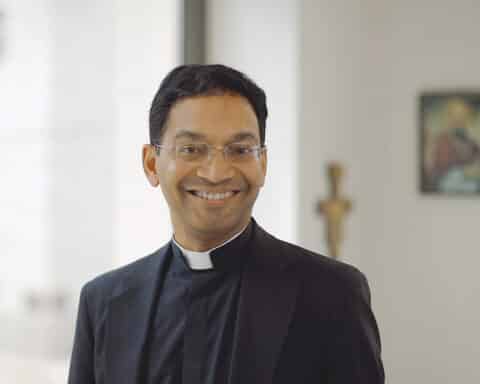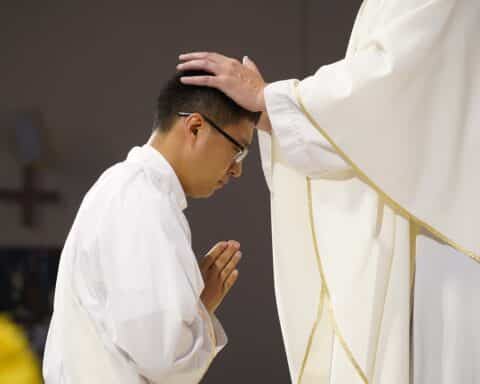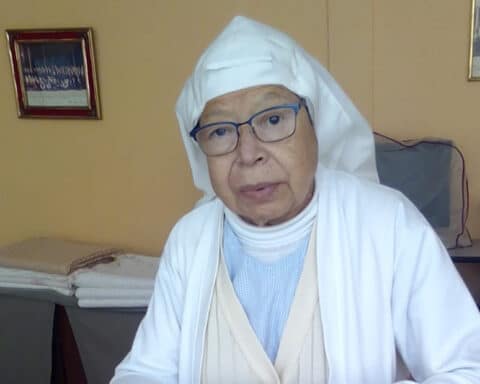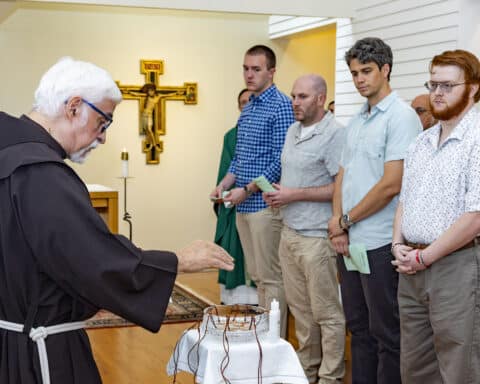For generations, men and women religious have produced products essential to the life of the Church. Without them, our priests would be without beautiful vestments, our altars would be without proper linens, and even more importantly, our bodies would be without the spiritual food found in holy Communion. Thankfully, there are still those who craft these necessities for Mass and carry on these important traditions with skillful attentiveness.
When Benedictine Father Vincent de Paul Crosby made vestments for the archabbot and other monks at Saint Vincent Archabbey in Latrobe, Pennsylvania, visiting priests often asked where the garments came from. Then they’d ask if he would make vestments for them, too.
In 1991, newly elected Archabbot Douglas Nowicki (now retired) gave Father Crosby the opportunity to create liturgical arts full time to help support the Benedictine community.
Read more from our Spring Vocations Special Section here.
At Archabbey Studios, Father Crosby designs and creates stained-glass windows, wall hangings for churches, book covers, altar dressings and other beautiful pieces that fulfill ritual requirements. He does sculptures, too, and recently completed one for St. Vincent Archabbey.
He’s nationally and internationally known for his vestments that have been worn by priests, deacons and bishops — even Pope St. John Paul II at World Youth Day in 2001. He designed the altar cloths when Pope Francis visited Philadelphia in 2015.
“When I returned from graduate school, I really intended to work in sculpture,” said Father Crosby, who has a master’s degree in fine arts from The Catholic University of America in Washington, D.C. “But the community needed me to work more in the area of liturgical art and vestments.”
He considers his work a ministry, not a business.
“It’s a vocation, and it fits in so beautifully with my life as a monk and a priest,” Father Crosby said. “My goal is to create something beautiful for the liturgy, and beauty is meant to be something that directs us to Beauty with a capital B — namely, God himself. My hope is to create something beautiful that will lead the viewer to the source of all beauty, which is God. Like an icon that is supposed to be a window into eternity, art is the window to the ultimate source of that beauty.”
Father Crosby makes vestments in many different fabrics with unique patterns and appliques. He consults the buyers before beginning design and throughout the process. Many vestments are unique expressions for where they will be worn, and by whom.
In 2013, he made a set of bright red vestments for St. Asaph Cathedral in North Wales. The design was based on the story of martyred St. Kentigern preaching in icy rivers, and on one occasion, a young disciple named Asaph brought hot coals to warm him. He carried them in an apron that was not scorched, a sign to St. Kentigern about the sanctity of Asaph, who was later martyred, too.
“I incorporated burning coals into the design to be symbolic of the burning zeal of the martyrs of North Wales,” Father Crosby said.
He makes two types of chasubles. One is the more common ample cut, and the other is the fuller conical vestment that’s based on ordinary early Roman dress.
“Once you put it on, the conical vestment is the most beautiful form because of the way it drapes,” he said.
Father Crosby added digital designs that he creates on a computer and sends out to be printed on panels. He then incorporates those pieces into vestments and wall hangings. For the latter, he recently completed an installation in the church of St. Mary’s Abbey in Morristown, New Jersey.
“We chose to play off the idea of the Communion of Saints,” he said. “So I did 24 10-foot hangings of 12 apostles and 12 Benedictine saints.”
All of his work focuses on revealing the meaning, capturing imagination and pointing to the mystery of faith.
“In ritual celebration, it’s not only the ministers who need to be vested well,” he said. “The objects used are also deserving of reverence. For that reason, we should take great care to dress the altar, veil the vessels, drape the cross, adorn the walls and cover the books.”
The making of altar bread
It took a couple of years and God’s grace, Sister Anne Marie Joerger said, for her to appreciate that working in the monastery bakery was one of her best places for prayer.
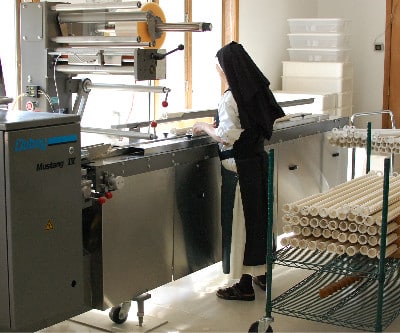
She didn’t realize that at first when she came to the Valley of Our Lady Monastery in Prairie du Sac, Wisconsin, where the Cistercian sisters annually make 9 million hosts for the people, plus altar bread for presiders and concelebrants.
Through the silent repetition of the simple work, she found a perfect time for prayer and reflection, pondering the Scriptures and praying for the needs of the world.
“Totally by the grace of God, it started to click for me. It was all there,” Sister Anne Marie said. “Our main task from God is prayer, and making altar bread supports us and pays our bills.”
It’s also in the Benedictine tradition of prayer and work.
Sister Anne Marie is now prioress of the community of 24 sisters. They produce altar bread for churches and chapels in Wisconsin and other states, Canada and even a customer in Australia.
“We let the people in the parishes and the priests know that we’re praying for them while we’re making this bread that we will ship to them,” she said.
She calls it a privilege for their community to make the bread of life. One day when she was in the bakery, she was overwhelmed with a sudden thought about how their work put them “on a physical kind of level that brings us closer to the Blessed Mother.”
“The Blessed Mother gave her body for forming what became the body of Christ,” Sister Anne Marie said. “We give our body — in our case, our hands — for forming the substance, the holy bread, that will become the body of Christ. I don’t take credit for making that connection. The thought just came to me totally from God.”
At the Monastery of St. Clare in Langhorne, Pennsylvania, the nine sisters of the Poor Clares at Langhorne begin their days with prayer, adoration and Mass. From Monday through Friday, four of them head to work for three hours in their altar bread room.
There they mix whole wheat (the most popular) or white flour with water and pour the batter onto two stoves for the standard thickness, and on another two stoves, they make thin wafers used by hospitals, nursing homes and Communion taken to the sick.

The sheets of bread are dampened and put into two humidifiers to soften for two days so that they don’t crumble when cut into hosts.
“Our main ministry here is prayer,” said Sister Anne Bartol, who manages the bakery. “We are always very conscious of that. We make the altar bread to support ourselves and as a way to participate in the Eucharistic life of the Church. We approach it from a very respectful perspective, very much recognizing what we are about.”
Every month, they send out 750,000 hosts to 400 customers around the country, with 80% of them in the Philadelphia area. Half of the hosts are sourced from other monasteries, and half are from their own bakery.
The sisters have made altar breads from the time they arrived in the area in 1917.
“St. Clare and her sisters made altar linens to pass out to the churches,” Sister Anne said. “In a way, it’s sort of a continuous line from that, that we are making the altar breads for churches.”
Maryann Gogniat Eidemiller writes from Pennsylvania.

